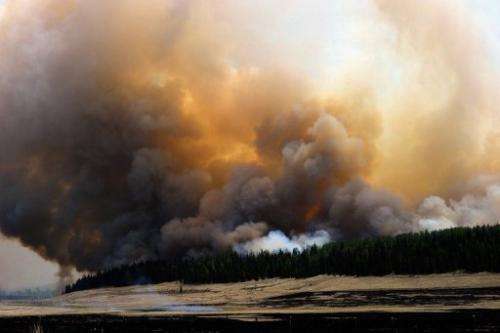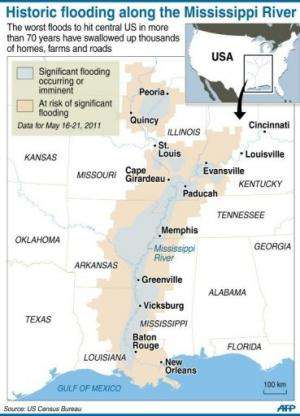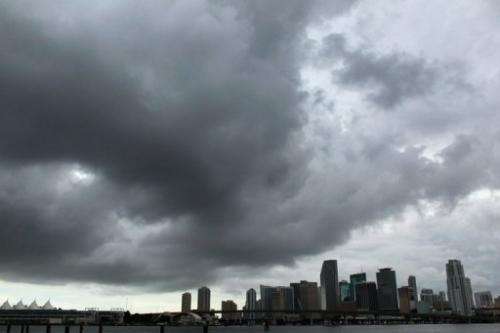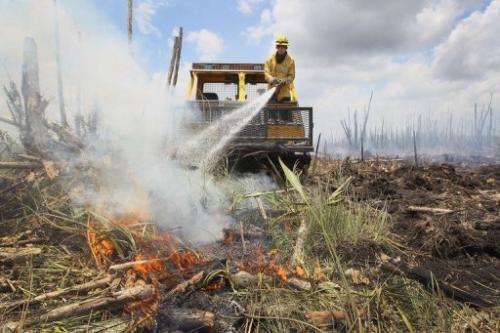Experts warn epic weather ravaging US could worsen

Epic floods, massive wildfires, drought and the deadliest tornado season in 60 years are ravaging the United States, with scientists warning that climate change will bring even more extreme weather.
The human and economic toll over just the past few months has been staggering: hundreds of people have died, and thousands of homes and millions of acres have been lost at a cost estimated at more than $20 billion.
And the United States has not even entered peak hurricane season.
"This spring was one of the most extreme springs that we've seen in the last century since we've had good records," said Deke Arndt, chief of climate monitoring for the National Oceanic and Atmospheric Administration (NOAA).
While it's not possible to tie a specific weather event or pattern to climate change, Arndt said this spring's extreme weather is in line with what is forecast for the future.
"In general, but not everywhere, it is expected that the wetter places will get wetter and the drier places will tend to see more prolonged dry periods," he told AFP.

"We are seeing an increase in the amount (of rain and snow) that comes at once, and the ramifications are that it's a lot more water to deal with at a time, so you see things like flooding."
More than 6.8 million acres in the central United States have been swamped after record spring rainfall overwhelmed rivers already swollen from the melting of a heavy winter snow pack.
Some levees burst under the pressure as the mighty Mississippi River swelled to more than three miles (nearly five kilometers) in width. Others were intentionally breached in order to ease pressure and protect cities downstream.
The latest flooding along the Missouri River has forced mass evacuations and threatened to inundate two nuclear power plants in Nebraska.
Meanwhile, the southern United States is dealing with one of the most extreme droughts since the dust bowl of the 1930s, and the dry conditions have led to massive and uncontrollable wildfires.
More than 4.7 million acres have been burned in some 32,000 separate fires so far this year, which is more than twice the annual average over the past decade, according to the National Interagency Fire Center.
Texas, Arizona and New Mexico have lost the most land, and one fire even spread to the grounds of the top US nuclear research lab on Monday.

As with the plants in Nebraska, officials said the nuclear material stored inside is safe and that no contaminants have been released.
While most people have been able to escape the slow-moving floodwaters and wildfires unharmed, the spring's violent storms have unleashed scenes of apocalyptic destruction.
Tornadoes have killed 542 people so far this year, making 2011 the deadliest tornado season since 1936 and the fourth worst on record, according to the National Weather Service.
Two bad days accounted for nearly all the deaths: an outbreak of dozens of tornadoes that killed 314 people in five southern states on April 27, and a nearly mile-wide twister that cut a six-mile (nearly 10 kilometer) swath of destruction through Joplin, Missouri on May 22, killing 146 people.
Climate change could bring less tornadoes, because while a warmer atmosphere will absorb more precipitation, causing more storms, it could also reduce the wind shear that builds storm intensity when cold and warm fronts collide.

However, the intensity of future droughts, heat waves, storms and floods is expected to rise drastically if greenhouse gas emissions don't stabilize soon, said Michael Mann, a scientist at Penn State University.
"Even a couple degree warming can make a 100-year event a three-year event," Mann, the head of the university's earth systems science center, told AFP.
"It has to do with the tail of the bell curve. When you move the bell curve, that area changes dramatically."
More extreme weather is expected in the coming months, said Jon Gottschalck, head of forecast operations at NOAA's climate prediction center.
"We're expecting warmer than normal conditions to continue across much of the south. The drought is probably going to continue in many areas," he said.
"We also expect wetter than normal conditions to continue for the next season or two in the northern Rockies...and an active hurricane season."
(c) 2011 AFP

















